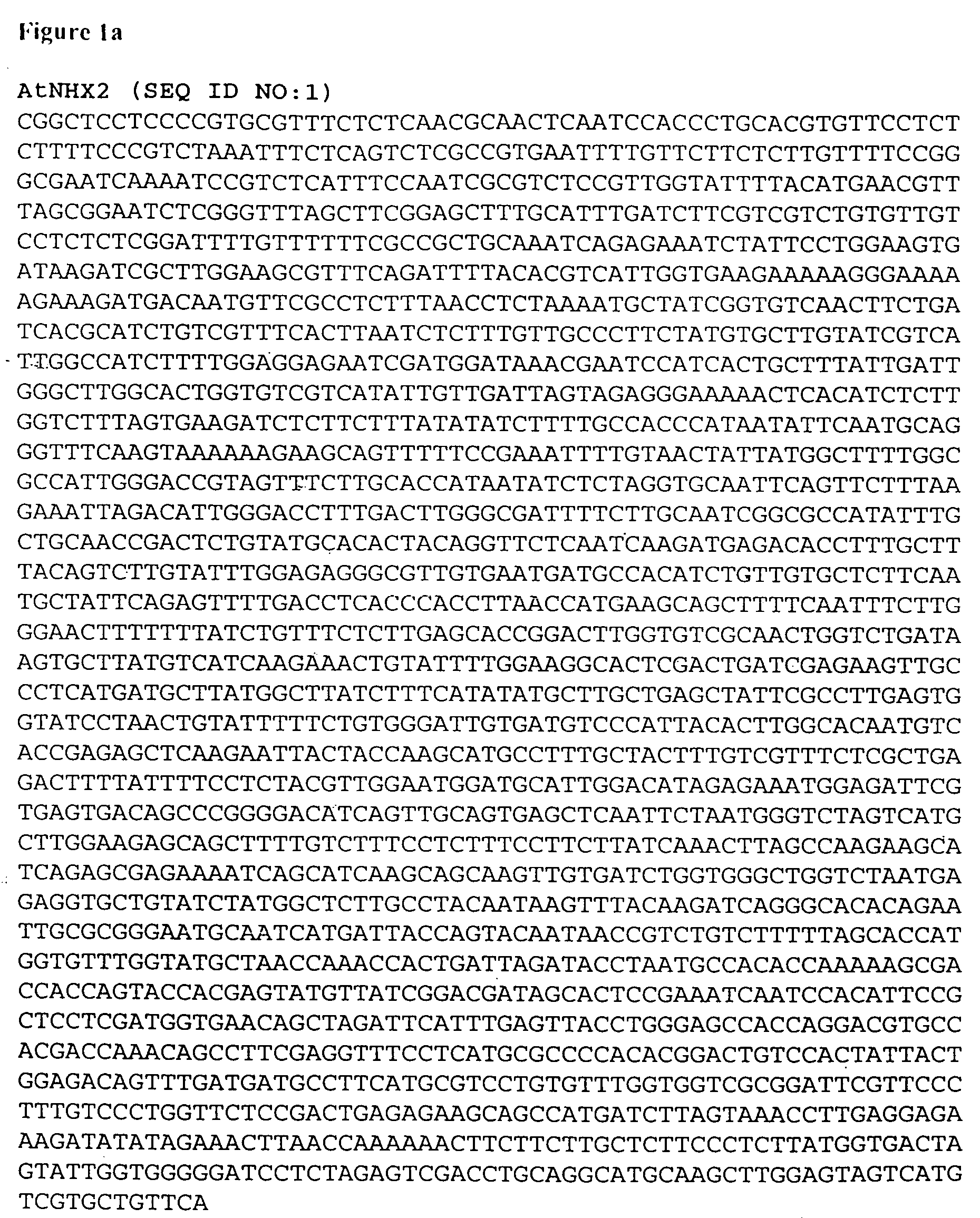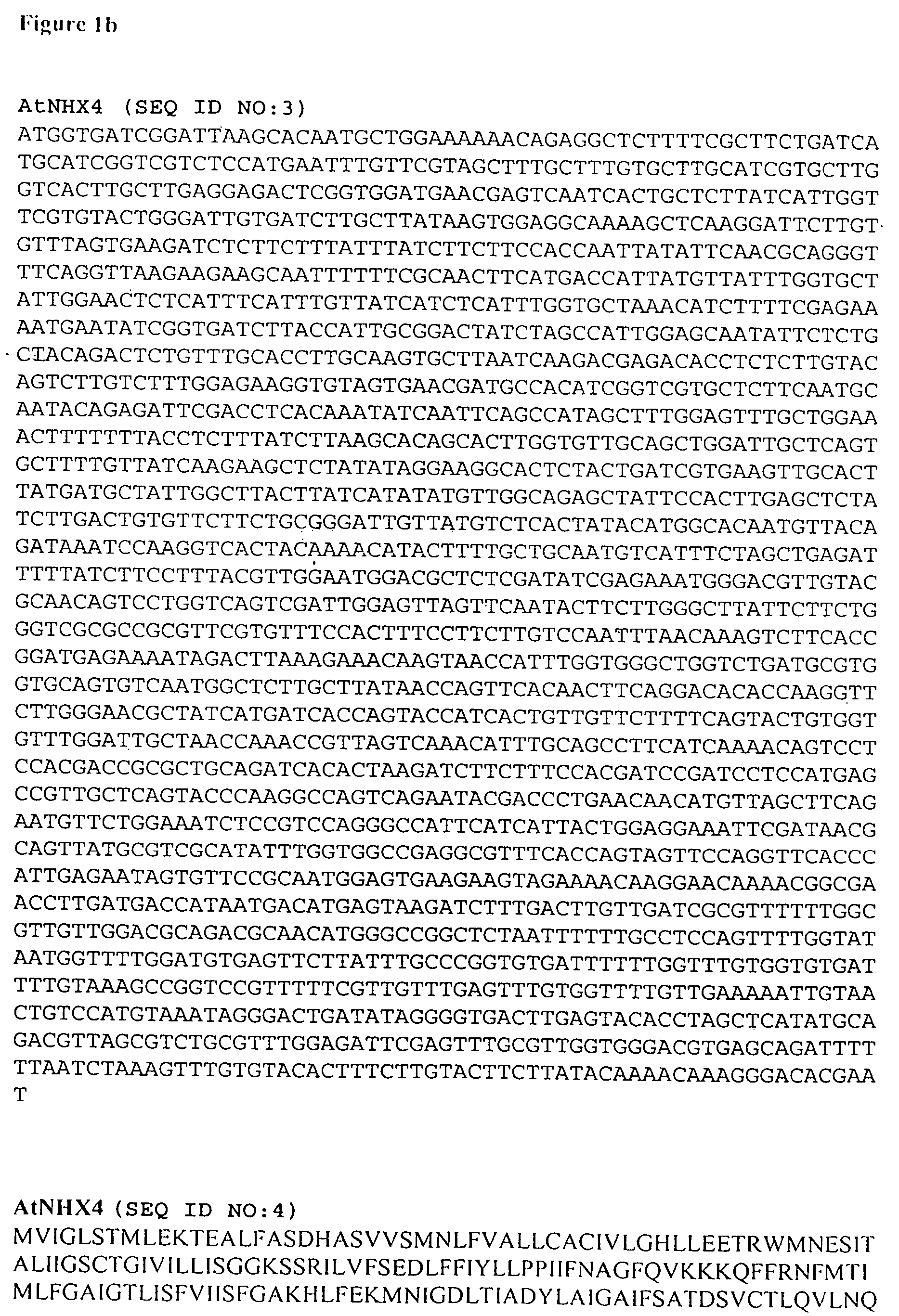Increasing salt tolerance in plants by overexpression of vacuolar Na+/H+ transporters
a technology of vacuolar na +/h + and plant salt, which is applied in the direction of plant/algae/fungi/lichens, peptides, tissue culture, etc., can solve the problems of large areas of the indian subcontinent being rendered unproductive, destroying ancient and recent agrarian societies, and extreme cost of measures
- Summary
- Abstract
- Description
- Claims
- Application Information
AI Technical Summary
Benefits of technology
Problems solved by technology
Method used
Image
Examples
example 1
Preparation of Polyclonal and Monoclonal Antibodies.
[0170] Hydropathy profiles of the Arabidopsis Na+ / H+ antiport revealed a relatively hydrophilic domain (at the C-terminus) with possible regulatory functions. The C-terminus was sub-cloned into the pGEX—2TK vector (Pharmacia) to allow the overexpression of the C-terminus polypeptide as a GST-fusion polypeptide in E. coli. The fusion polypeptide was purified by glutathione-affinity chromatography and used as an antigen in rabbits to obtain polyclonal antibodies (30).
[0171] Monoclonal antibodies are prepared in mice hybridomas according to established techniques (30) using the C-terminus polypeptide as described above. Polyclonal and monoclonal antibodies raised against other regulatory regions of the Arabidopsis Na+ / H+ antiport are also obtained as described above. The invention includes the antibodies and the hybridoma which secretes the monoclonal antibodies.
example 2
Identification of Homologous Nucleic Acid Molecules from Other Plant Species, Preferably Salt Tolerant Species.
[0172] Several experimental approaches are used to identify homologous nucleic acid molecules from salt tolerant species. a) We screen cDNA and genomic libraries from sugar beets (a moderate salt-tolerant crop, also known as red beet) under low-stringency conditions with an Arabidopsis Na+ / H+ antiport cDNA as a probe (31); b) We apply PCR techniques using degenerate oligonucleotide primers designed according to the conserved regions of the Arabidopsis Na+ / H+ antiport (32); c) We screen cDNA expression libraries from different plants (salt-tolerant and salt-sensitive) using antibodies raised against an Arabidopsis Na+ / H+ antiport (31). We also use bioinformatics techniques to identify nucleic acid molecules. The invention includes methods of using such a nucleic acid molecule, for example to express a recombinant polypeptide in a transformed cell.
[0173] The techniques des...
example 3
Overexpression of the PNHX Transporter Preferably Arabidopsis Transporter (AtNHX).
[0174] The Na+ / H+ antiport is expressed in Arabidopsis plants, although the wild type plants show impaired growth at NaCl concentrations higher than 75 mM. The Na+ / H+ antiport is overexpressed in these plants in order to improve their tolerance to high salt concentrations. A full length cDNA (preferably coding for the AtNHX1 polypeptide (AtNHX2, AtNHX3 or AtNHX4) cloned from an Arabidopsis thaliana (Columbia) seedling cDNA library is ligated into a pB1NS1 vector (33). This vector contains a constitutively strong promotor (“super-promotor” (20)). Also, T-DNA vectors (pBECKS) are used (34). Constructs containing the AtNHX1 cDNA with the full Na+ / H+ antiport open reading frame in a sense orientation were selected by colony hybridization using the AtNHX1 as a probe and by restriction-digest analysis using BglII restriction endonuclease. These constructs are used to transform Agrobacterium tumefaciens, an...
PUM
 Login to View More
Login to View More Abstract
Description
Claims
Application Information
 Login to View More
Login to View More - R&D
- Intellectual Property
- Life Sciences
- Materials
- Tech Scout
- Unparalleled Data Quality
- Higher Quality Content
- 60% Fewer Hallucinations
Browse by: Latest US Patents, China's latest patents, Technical Efficacy Thesaurus, Application Domain, Technology Topic, Popular Technical Reports.
© 2025 PatSnap. All rights reserved.Legal|Privacy policy|Modern Slavery Act Transparency Statement|Sitemap|About US| Contact US: help@patsnap.com



